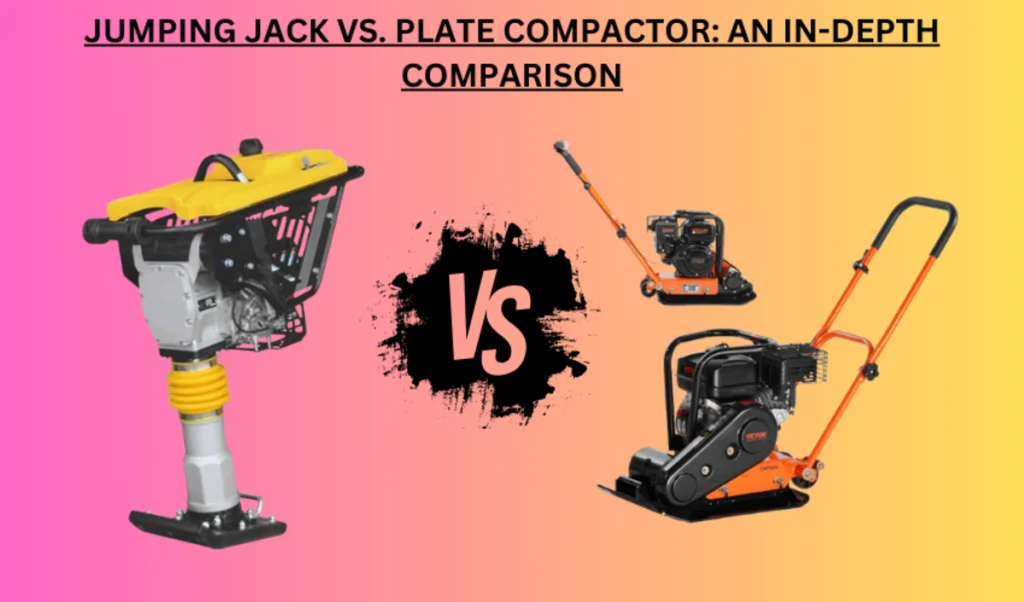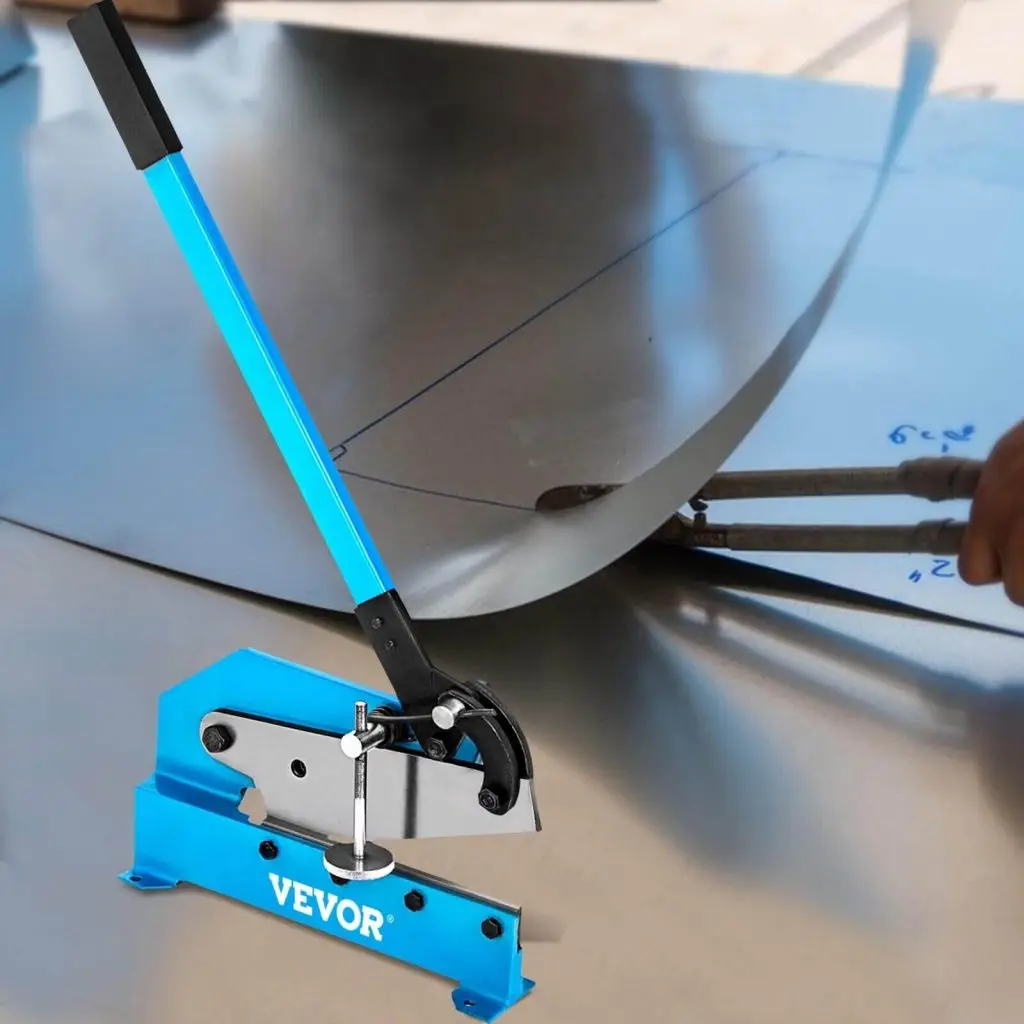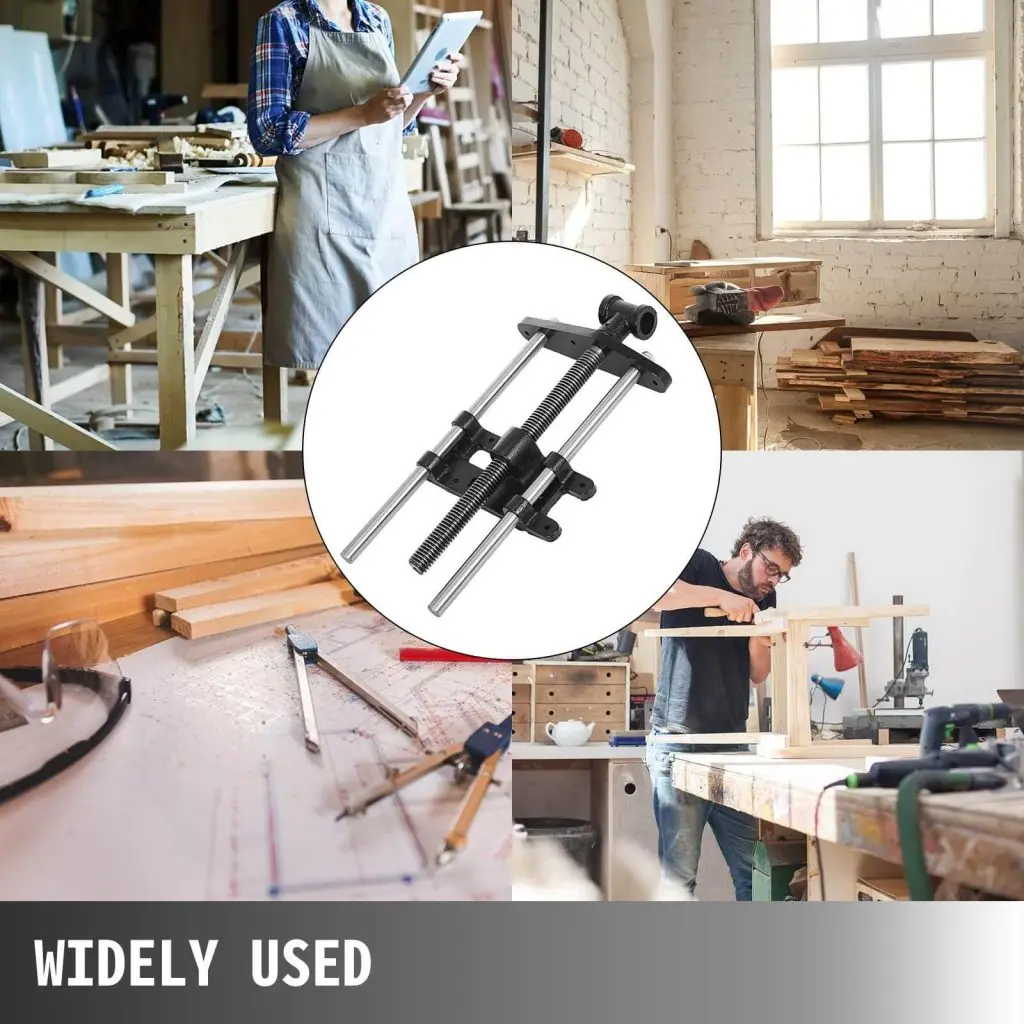Introduction
Would you instead go with the known range of Jumping Jacks or the innovative range of Plate Compactors? Which one you choose for your construction projects? Realizing their significance and the differences is crucially important. Jumping Jacks are perfect for tight areas because of their quick agility, while Plate Compactors provide more considerable area coverage. This guide will resolve this conflict by presenting a comparative analysis. Literally, by knowing each one’s purpose and the benefits. It will help you decide between jumping jack vs plate compactor wisely. Let’s discover the differences between Jumping Jacks and Plate Compactors wisely so that you can effectively manage your construction.
Table of contents
Understanding Jumping Jacks
A. Definition and jumping jack construction
Apart from the popular name Jumping Jack. You can also define it as a manual compactor. It is equipment you can use to compact the soil and asphalt surfaces. The construction consists of a heavy steel plate connected to a vertical handle. An engine-powered mechanism in the handle that places the vertical force on the plate exists.
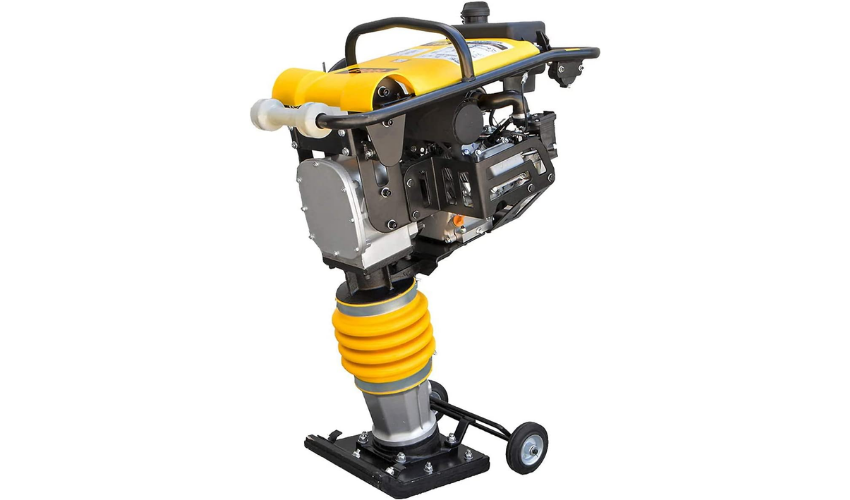
B. Working mechanism
You pull the jumping jack equipment up by its handles and drop it down repeatedly onto the surface when in use. The force formed compacts material underneath, leading to the reduction of air voids and increasing masses. This way you can ensure the Stability and strength of the surface.
C. Applications
Jumping jacks have a wide range of uses in construction operations, which include compaction of trenches, foundations, and road surfaces. They are outstanding in places bigger compacters cannot get to.
Plate Compactors Explained
A. Definition and design
Plate compactors are potent machines used in construction to compact soil, gravel or asphalt. They comprise a heavy steel plate, an engine and an operation handle. The plate is flat and oscillates fast to pack the material below.
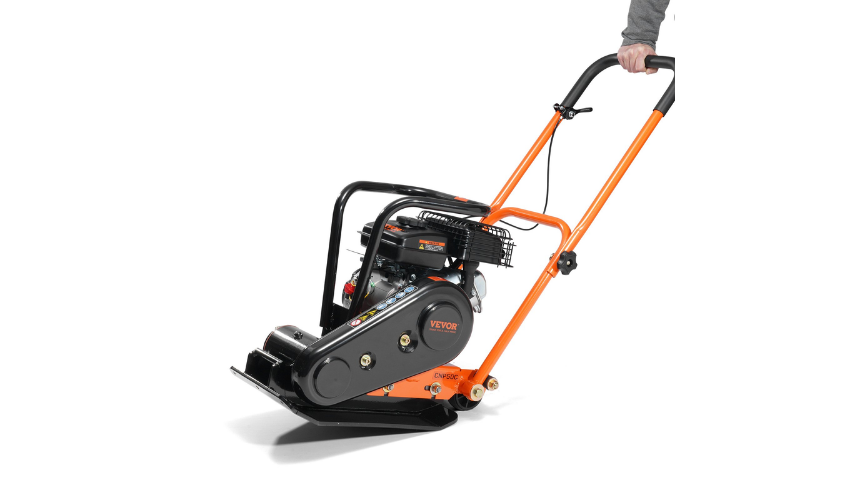
B. Working mechanism
When you start the plate compactor, the engine drives the vibration of the plate, whereby it moves up and down very quickly. You move the plate over the surface while the vibrating plate puts downward pressure on material particles, thus compacting them. This method eradicates the air voids and enhances the denser, more robust surface.
C. Applications
You can use plate compactors for multiple purposes, such as compressing soil before laying a foundation for buildings/roads. They’re also suitable for complying gravel or crushed stone in driveways, walkways, and parking lots. Subsequently, you can use plate compactors in asphalt paving to achieve further compaction and smoothness.
Plate Compactor Vs. Jumping Jack
| Sr. No. | Parameters | Jumping Jack | Plate Compactor |
| 1 | Power Source | Gas or electric | Gas or electric |
| 2 | Compaction Depth | Up to 8 inches | Up to 18 inches |
| 3 | Maneuverability | Excellent in tight spaces | Limited in tight spaces |
| 4 | Surface Finish | Uneven with ridges | Smooth and uniform |
| 5 | Suitable Materials | Cohesive soils (clay, silt) | Granular soils (sand, gravel) |
| 6 | Operation Speed | Slower in large areas | Faster in large areas |
| 7 | Cost | Generally less expensive | Generally more expensive |
| 8 | Noise Level | Lower | Higher |
Design and Mechanism:
Plate Compactor: It comprises a heavy flat plate that goes down and up quickly to crush the soil and asphalt. The plate is powered by a gasoline or diesel engine fitted on a wheeled chassis for mobility.
Jumping Jack: Commonly referred to as a tamping rammer, it knocks up and down at high speed with a smaller foot/shoe to compress the soil. Jumping jack equipment utilises a two-stroke engine that calls for the operator’s manipulation and control of movement.
Performance:
Plate Compactor: Suitable for more extensive, flatter areas, e.g., driveways and parking lots. It provides a high compaction force coverage over a wide area per pass, making it ideal for more significant projects.
Jumping Jack: Suitable for trenching or around pipes purposes. It features accessible accommodation in tight or narrow spaces. Its compact size enables it to access spaces unreachable by plate compactors. Thereby ensuring a thorough compacting in tight spaces.
Manoeuvrability:
Plate Compactor: It is easy to deploy on all flat surfaces due to its wheel chassis. But it might have trouble in tight or irregular terrain.
Jumping Jack: It provides better manoeuvrability, enabling you to go around barriers and narrow spots precisely.
Versatility:
Plate Compactor: Dual purpose for both soil and asphalt compaction. You can apply it on surfaces such as gravel, sand, and cohesive soils.
Jumping Jack: Mainly intended for soil compaction. However, jumping jack equipment can handle some asphalt compaction. It is less effective on hard surfaces relative to plate compactors.
Compaction Speed:
Plate Compactor: Due to its more comprehensive plate, it covers large areas quickly, making it more effective on larger projects.
Jumping Jack: Less swift than plate compactors due to their compact size. To do the same degree of compaction, it needs more passes.
Soil Type Considerations:
Plate Compactor: Wide-range applicability to granular and cohesive soils. It compels a vast range of residential and commercial construction projects.
Jumping Jack: The high impact force of the jumping jack is suitable for cohesive soils like clay or silt that compact well. In contrast, it will have difficulties working with gravel and sandy soils
Total Cost:
Plate Compactor: The price of the plate compactor is higher than the latter. But in the long term, efficiency is the clear winner.
Jumping Jack: Usually have the lower cost. But this is only suitable when working on smaller projects. For large projects, it incurs more maintenance costs.
Skill of The Operator:
Plate Compactor: No training is needed to operate the plate compactor. Even the beginner can begin using this device on the go. This is because of the intuitive controls.
Jumping Jack: This device requires a higher level of training and skills. The correct technique ensures complete compaction without harm to the surrounding environment.
Maintenance:
Plate Compactor: Routine maintenance involves checking the oil level, cleaning the air filter, and examining the disc for signs of deterioration. Generally, maintenance is quite simple, and the operator can do it.
Jumping Jack: It needs routine servicing of the engine consisting of a spark plug change, fuel system cleaning, and air filter check. You must observe the plate for wear and tear and tighten loose bolts.
Compaction Depth & Surface Finish
In Plate Compactors vs. Jumping Jacks, Compaction Depth and Surface Finish matter. Plate Compactors provide deeper compaction depths, up to 18 inches, perfect for more significant projects. They yield a consistent and even surface finish suitable for driveways and parking lots. In contrast, Jumping Jacks have a compaction depth of about 8 inches, which makes them perfect for confined areas. But their surface quality may be unevenly ridged. Select the equipment that suits your size project and surface requirements. Achieve the highest efficiency and the quality output possible with the right compaction tool for the task.
Jumping Jack Vs Plate Compactor: Factors Influencing the Decision
Project Scope and Size:
When deciding on a plate compactor vs a jumping jack, choose by the size of your contract. For vminimalareas like trenches or tight spaces, a Jumping Jack is better. A Plate Compactor will generally be more practical for driveways and parking lots.
Soil Type and Conditions:
Evaluate the soil you are going to compact. A Plate Compactor is generally preferable if it’s cohesive or mixed with gravel. In the case of the granular soils, the Jumping Jack will deliver a better compaction effect.
Compaction Efficiency:
Plate Compactors have a higher overall force thrust but over a larger area. Hence, they are faster and more effective for compaction of larger surfaces. Jumping Jacks, having a vertical impact action. They are more effective in compacting more deeply to the matter of compaction in limited spaces.
Budget Considerations:
Traditionally, Jumping Jacks are more cost-effective upfront, which makes them an economical choice for smaller-scale jobs. Plate Compactors generally have a higher initial price but, at the same time, can provide better long-term returns.
Versatility and Application Range:
Plate Compactors can span the range of their work, such as asphalt and cohesive soils. Jumping jacks feature limitations, but they shine in trench compaction, backfill compaction, and compaction of narrow areas.
Transportation and Portability:
Think about how easily you can transport and move around the plate compactor vs jumping jack equipment. Generally, Jumping Jacks are lighter and more portable, which makes them perfect for projects in places that are difficult to reach. Transportation of Plate Compactors may need a bigger vehicle.
Speed of Operation:
Plate Compactors have a larger base plate size and a forward drive, covering more ground quicker. Jumping Jacks take more manoeuvring and could be slower for more extensive areas. However, this machine has a greater compaction depth in tight spaces.
Long-Term Maintenance Costs:
Consider maintenance and repair costs for plate compactor vs jumping jack. Plate Compactors are more complex, which makes them have a higher initial maintenance cost. But it needs servicing less frequently compared to Jumping Jacks, which are simple. Please note the latter needs frequent maintenance as compared to Plate Compactors.
Durable and Qualitative Compactor Products Worth Considering
2.8 HP VEVOR Plate Compactor
Raise your construction level using the VEVOR Plate Compactor. Powered by a potent 2.8 HP 78.5CC gas engine, it gives 5,250 VPM and 1,920 lbs of force.
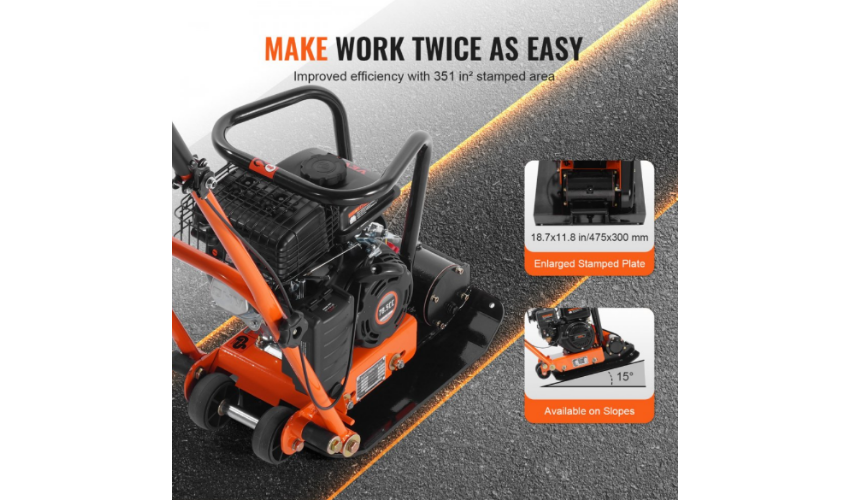
Experience unparalleled power: The 78.5 cc / 2.8 HP gasoline engine provides strong performance with 5,250 VPM and 8 inches compaction depth.
Maximise efficiency: Achieve up to 5400 ft²/h with a large 221 in² stamped plate.
Enjoy ease of movement: The wide, tyre-like, sturdy wheels and the structure weigh 105.8 lbs, accumulating in easy transfer for road maintenance tasks.

Operate with simplicity: Have an easy time controlling the speed as the adjustable choke and linear throttle modify the speed range.
6.5 HP VEVOR Plate Compactor
Say hello to the VEVOR Vibratory Compaction Tamper – your go-to option for knocking out those compacting jobs like a pro!

Let the strength of our monster-level engine: At 5,600 vibrations per minute and with a 12-inch compaction depth, it delivers the best results.
Upgrade your road projects: Equipped with 351 in² square plate is 7,300 ft²/h work efficiency and 8 mm thickness.
Get on the road quickly. The VEVOR vibratory compactor-wide, wearing-resistant wheels provide smooth travel on every surface.
FAQs
What is the capacity of a jumping compactor?
The size and specifications determine a jumping compactor’s capacity. MLargerjumping compactors can handle compacting a wider area much faster. For smaller models, you probably can assume a capacity of 700 to 800 square meters per hour. On top of that, more giant machines process more than 1000 square meters per hour.
What is the distinction between ramming and tamping?
Ramming usually compresses the ground in plain concrete, not for RCC or the top floor. Tamping entails hitting the top surface with a wooden cross beam. Recall that ramming is the compaction of the ground, while tamping is finishing the surface. Select the approach depending on your construction requirements and location.
How deep will a plate compactor work?
Ordinarily, a plate compactor efficiently compiles soil or other material up to 12 inches deep. Most of the time, such depth is enough for the bulk of concrete finishing jobs.
Conclusion
Having looked at the differences between jumping jacks and vandplate compactor, you should decide which one to use. Realising their power, you can choose the most appropriate tool for you. Remember that the right equipment will save you time and energy on your projects. Are you ready for a quality investment? Try VEVOR now. With their hassle-free range of jumping jacks and plate compactors, you will guarantee efficiency and robustness. Don’t wait; Discover more qualitative and reliable masonry & concrete & tile tools by VEVOR.

